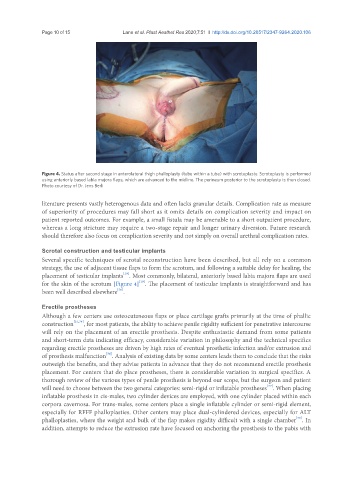Page 594 - Read Online
P. 594
Page 10 of 15 Lane et al. Plast Aesthet Res 2020;7:51 I http://dx.doi.org/10.20517/2347-9264.2020.106
Figure 4. Status after second stage in anterolateral thigh phalloplasty (tube within a tube) with scrotoplasty. Scrotoplasty is performed
using anteriorly based labia majora flaps, which are advanced to the midline. The perineum posterior to the scrotoplasty is then closed.
Photo courtesy of Dr. Jens Berli
literature presents vastly heterogenous data and often lacks granular details. Complication rate as measure
of superiority of procedures may fall short as it omits details on complication severity and impact on
patient reported outcomes. For example, a small fistula may be amenable to a short outpatient procedure,
whereas a long stricture may require a two-stage repair and longer urinary diversion. Future research
should therefore also focus on complication severity and not simply on overall urethral complication rates.
Scrotal construction and testicular implants
Several specific techniques of scrotal reconstruction have been described, but all rely on a common
strategy, the use of adjacent tissue flaps to form the scrotum, and following a suitable delay for healing, the
[19]
placement of testicular implants . Most commonly, bilateral, anteriorly based labia majora flaps are used
[19]
for the skin of the scrotum [Figure 4] . The placement of testicular implants is straightforward and has
[76]
been well described elsewhere .
Erectile prostheses
Although a few centers use osteocutaneous flaps or place cartilage grafts primarily at the time of phallic
construction [21,74] , for most patients, the ability to achieve penile rigidity sufficient for penetrative intercourse
will rely on the placement of an erectile prosthesis. Despite enthusiastic demand from some patients
and short-term data indicating efficacy, considerable variation in philosophy and the technical specifics
regarding erectile prostheses are driven by high rates of eventual prosthetic infection and/or extrusion and
[76]
of prosthesis malfunction . Analysis of existing data by some centers leads them to conclude that the risks
outweigh the benefits, and they advise patients in advance that they do not recommend erectile prosthesis
placement. For centers that do place prostheses, there is considerable variation in surgical specifics. A
thorough review of the various types of penile prosthesis is beyond our scope, but the surgeon and patient
[77]
will need to choose between the two general categories: semi-rigid or inflatable prostheses . When placing
inflatable prosthesis in cis-males, two cylinder devices are employed, with one cylinder placed within each
corpora cavernosa. For trans-males, some centers place a single inflatable cylinder or semi-rigid element,
especially for RFFF phalloplasties. Other centers may place dual-cylindered devices, especially for ALT
[76]
phalloplasties, where the weight and bulk of the flap makes rigidity difficult with a single chamber . In
addition, attempts to reduce the extrusion rate have focused on anchoring the prosthesis to the pubis with

